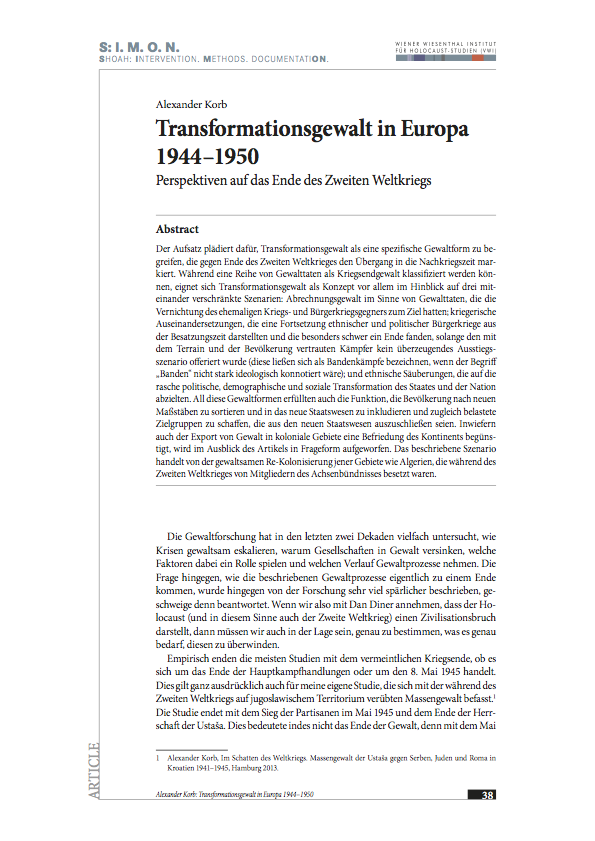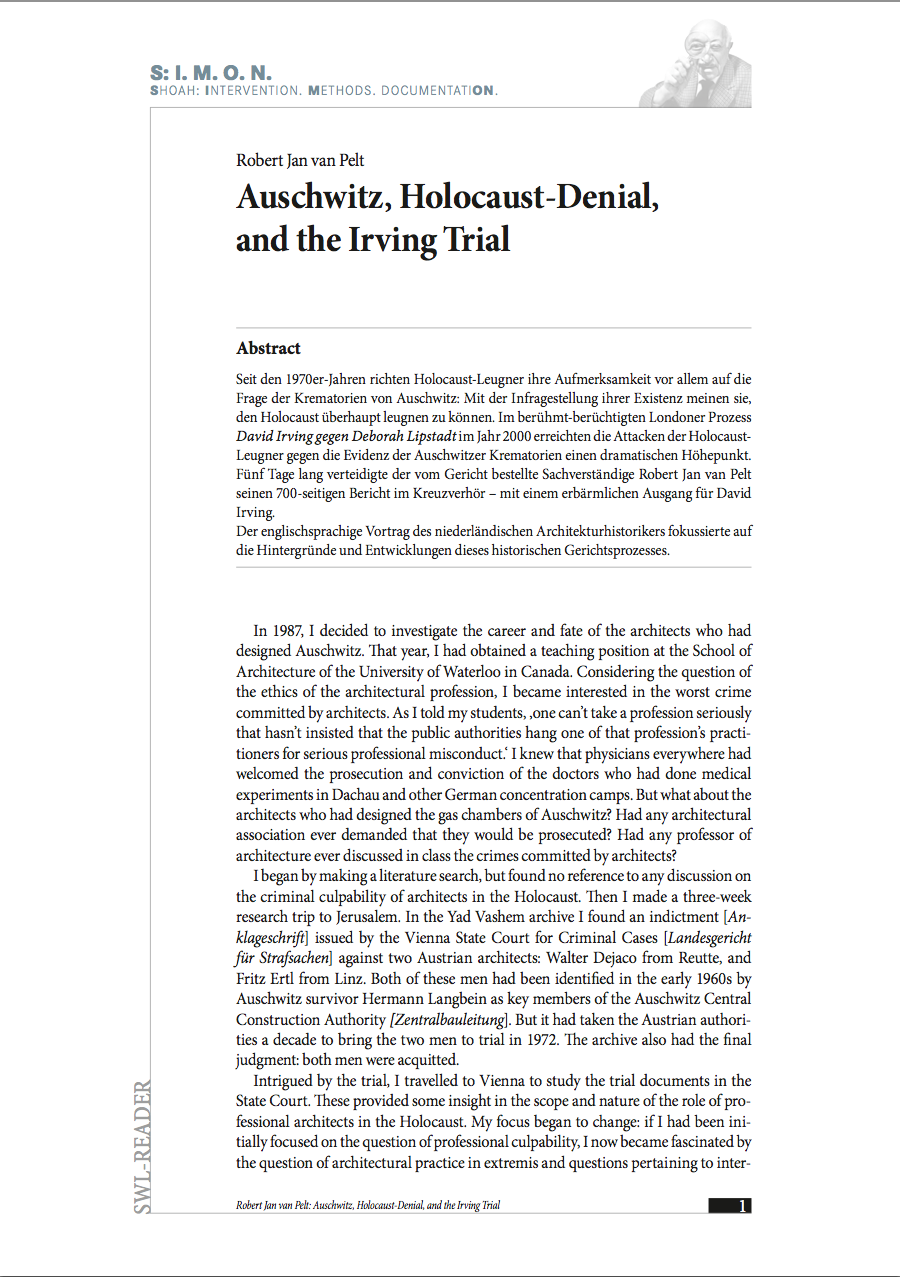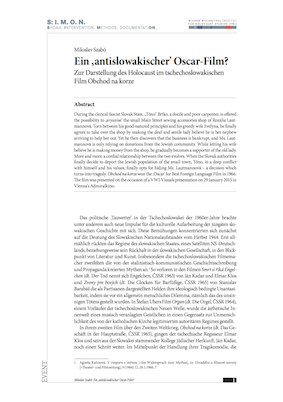 In 1992, the government of the Federal Republic of Germany decided to dedicate a memorial to the victims of the genocide of Sinti and Roma. The Memorial for the Sinti and Roma of Europe murdered under National Socialism by the artist Dani Karavan was inaugurated in October 2012 in the centre of Berlin, near the former Reichstag building. The planning and construction phase spanned two decades, during which many discussions addressed the significance awarded to the Nazi persecution of “gypsies” next to the Holocaust. These discussions reached an apex in a controversy enacted via media between Yehuda Bauer (then the director of the International School for Holocaust Studies in Yad Vashem) and Romani Rose (the head of the Central Council of German Sinti and Roma). This paper critically reflects the debates in light of new research results on the genocide of Sinti and Roma.
In 1992, the government of the Federal Republic of Germany decided to dedicate a memorial to the victims of the genocide of Sinti and Roma. The Memorial for the Sinti and Roma of Europe murdered under National Socialism by the artist Dani Karavan was inaugurated in October 2012 in the centre of Berlin, near the former Reichstag building. The planning and construction phase spanned two decades, during which many discussions addressed the significance awarded to the Nazi persecution of “gypsies” next to the Holocaust. These discussions reached an apex in a controversy enacted via media between Yehuda Bauer (then the director of the International School for Holocaust Studies in Yad Vashem) and Romani Rose (the head of the Central Council of German Sinti and Roma). This paper critically reflects the debates in light of new research results on the genocide of Sinti and Roma.
Editorial
 S:I.M.O.N. is an e-journal of the Vienna Wiesenthal Institute for Holocaust Studies (VWI). It appears twice a year in English and German language. S:I.M.O.N. aims at both a transnational and comparative history of the Holocaust and Jewish Studies in Central and Eastern Europe within the broader contexts of the European history of the 20th and 21st century, including its prehistory, consequences and legacies as well as the history of memory.
S:I.M.O.N. is an e-journal of the Vienna Wiesenthal Institute for Holocaust Studies (VWI). It appears twice a year in English and German language. S:I.M.O.N. aims at both a transnational and comparative history of the Holocaust and Jewish Studies in Central and Eastern Europe within the broader contexts of the European history of the 20th and 21st century, including its prehistory, consequences and legacies as well as the history of memory.
S:I.M.O.N. serves as a forum for discussion of various methodological approaches. The journal especially wishes to strengthen the exchange between researchers from different scientific communities and to integrate both the Jewish history and the history of the Holocaust into the different “national” narratives. It also lays a special emphasis on memory studies and the analysis of politics of memory. S:I.M.O.N. uses a double-blind review system, which means that both the reviewer’s and the author’s identities are concealed from each other hroughout the review process.
Shoah: The journal deals with the history of the Shoah from multidisciplinary, transnational and comparative perspectives. It seeks to integrate studies on Jews as well as on other groups of victims of the Holocaust, especially on Roma, and of so far less researched regions of (East) Central and (South) Eastern Europe.
Intervention. The journal reports on research projects and their transmission into public events. It also informs about current educational and remembrance programs.
Methods. The journal serves as a forum for the discussion of methodological approaches as, for instance, the everyday history, oral history, gender history, the history of violence, anti-Semitism and racism and the theory of memory and memory politics.
DocumentatiON. The journal contributes to critical approaches on using and interpreting archival materials in the 21st century.
Download the current issue S:I.M.O.N. 2017/2.
Articles
Alexander Korb
Transformationsgewalt in Europa 1944–1950. Perspektiven auf das Ende des Zweiten Weltkriegs
 This essay proposes that transformation violence be considered a particular form of violence that marked the transition to the post-war period towards the end of the Second World War. While a series of violent acts can be classified as wartime violence, transformation violence is a useful concept that can be applied in particular to three interlocked scenarios: settlement violence, meaning violent acts that aimed to destroy the former enemy in war and civil war; acts of war that constituted a continuation of ethnic and political civil wars from the occupation era and which were particularly hard to put to an end as long as the fighters familiar with the territory and the population were not given a convincing exit scenario (these might be described as gang wars if the term “gangs” did not carry such a strong ideological connotation); lastly, ethnic cleansing that aimed at a rapid political, demographic and social transformation of the state and the nation. These forms of violence all also had the purpose of arranging the population by new measures and to draw them into the new political system while at the same time creating loaded target groups who were to be excluded from the new political system. Finally, the article raises the question whether the export of violence into colonial territories aided the peacemaking efforts on the continent. It describes the scenario of violent re-colonialisation of territories like Algeria, which had been occupied by members of the axis powers during the Second World War.
This essay proposes that transformation violence be considered a particular form of violence that marked the transition to the post-war period towards the end of the Second World War. While a series of violent acts can be classified as wartime violence, transformation violence is a useful concept that can be applied in particular to three interlocked scenarios: settlement violence, meaning violent acts that aimed to destroy the former enemy in war and civil war; acts of war that constituted a continuation of ethnic and political civil wars from the occupation era and which were particularly hard to put to an end as long as the fighters familiar with the territory and the population were not given a convincing exit scenario (these might be described as gang wars if the term “gangs” did not carry such a strong ideological connotation); lastly, ethnic cleansing that aimed at a rapid political, demographic and social transformation of the state and the nation. These forms of violence all also had the purpose of arranging the population by new measures and to draw them into the new political system while at the same time creating loaded target groups who were to be excluded from the new political system. Finally, the article raises the question whether the export of violence into colonial territories aided the peacemaking efforts on the continent. It describes the scenario of violent re-colonialisation of territories like Algeria, which had been occupied by members of the axis powers during the Second World War.
SWL-Reader
Robert Jan van Pelt
Auschwitz, Holocaust-Denial, and the Irving Trial
 Since the 1970s, Holocaust deniers have focused their attention especially on the issue of crematoria in Auschwitz, thinking that questioning the existence of these would enable them to deny the Holocaust itself. The Holocaust deniers' attacks against the evidence of the Auschwitz crematoria reached a dramatic apex during the infamous London court case David Irving against Deborah Lipstadt in the year 2000. Court-ordered expert Robert Jan van Pelt defended his 700 page report under cross examination for five days – the outcome was pathetic for David Irving.
Since the 1970s, Holocaust deniers have focused their attention especially on the issue of crematoria in Auschwitz, thinking that questioning the existence of these would enable them to deny the Holocaust itself. The Holocaust deniers' attacks against the evidence of the Auschwitz crematoria reached a dramatic apex during the infamous London court case David Irving against Deborah Lipstadt in the year 2000. Court-ordered expert Robert Jan van Pelt defended his 700 page report under cross examination for five days – the outcome was pathetic for David Irving.
The Dutch architectural historian's lecture in English focused on the background and developments of this historical court case.
Events
Miloslav Szabó
Ein ‚antislowakischer' Oscar-Film? Zur Darstellung des Holocaust im tschechoslowakischen Film Obchod na korze
 During the clerical-fascist Slovak State, "Tóno" Brtko, a docile and poor carpenter, is offered the possibility to 'aryanise' the small Main Street sewing accessories shop of Rozália Lautmannová. Torn between his good-natured principles and his greedy wife Evelyna, he finally agrees to take over the shop by making the deaf and senile lady believe he is her nephew arriving to help her out. Yet he then discovers that the business is bankrupt, and Ms. Lautmannová is only relying on donations from the Jewish community. While letting his wife believe he is making money from the shop, he gradually becomes a supporter of the old lady. More and more, a cordial relationship between the two evolves. When the Slovak authorities finally decide to deport the Jewish population of the small town, Tóno, in a deep conflict with himself and his values, finally opts for hiding Ms. Lautmannová – a decision which turns into tragedy. Obchod na korze won the 'Oscar' for Best Foreign Language Film in 1966. The film was presented on the occasion of a VWI-Visuals presentation on 29 January 2015 in Vienna's Admiralkino.
During the clerical-fascist Slovak State, "Tóno" Brtko, a docile and poor carpenter, is offered the possibility to 'aryanise' the small Main Street sewing accessories shop of Rozália Lautmannová. Torn between his good-natured principles and his greedy wife Evelyna, he finally agrees to take over the shop by making the deaf and senile lady believe he is her nephew arriving to help her out. Yet he then discovers that the business is bankrupt, and Ms. Lautmannová is only relying on donations from the Jewish community. While letting his wife believe he is making money from the shop, he gradually becomes a supporter of the old lady. More and more, a cordial relationship between the two evolves. When the Slovak authorities finally decide to deport the Jewish population of the small town, Tóno, in a deep conflict with himself and his values, finally opts for hiding Ms. Lautmannová – a decision which turns into tragedy. Obchod na korze won the 'Oscar' for Best Foreign Language Film in 1966. The film was presented on the occasion of a VWI-Visuals presentation on 29 January 2015 in Vienna's Admiralkino.
Karola Fings: Opferkonkurrenzen. Debatten um den Völkermord an den Sinti und Roma und neue Forschungsperspektiven
„... zu lesen, wenn alles vorüber ist“
Rita Maria Rockenbauer, Briefe 1938 –1942
Wien 2014
Partituren der Erinnerung.
Der Holocaust in der Musik
Scores of Commemoration.
The Holocaust in Music
Wien 2015
Before the Holocaust Had Its Name. Early Confrontations of the Nazi Mass Murder of the Jews
Wien 2016
Akademisches Milieu, Juden und Antisemitismus an den Universitäten Europas zwischen 1918 und 1939
Academic Milieu, Jews and Antisemitism at European Universities between 1918 and 1939
Wien 2016






